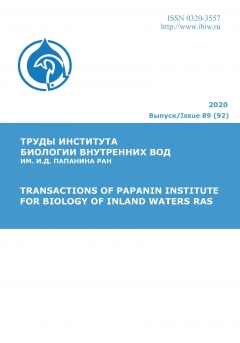УДК 546.654 Лантан
Изучены ответные реакции лабораторной культуры Hyalella azteca на действие растворов сульфата лантана в диапазоне концентраций 0.16–160 мкмоль/л в условиях хронического эксперимента. Показано, что смертность H. azteca возрастала при увеличении концентрации La3+ в растворе. Последовательное повышение концентраций La3+ приводило к закономерному увеличению потребления пищи. К наиболее информативной тест-функции при оценке токсичности La3+ можно отнести длину и массу H. azteca, не информативным — длину и количество члеников антенн.
лантан, биотестирование, выживаемость, рост, пищевое поведение, Hyalella azteca, хроническая токсичность
1. Кабата-Пендиас А., Кабата-Пендиас Х. Микроэлементы в почвах и растениях. М.: Мир, 1989. 439 с.
2. Ложкина Р.A., Томилина И.И. Влияние лантана на биологические параметры ветвистоусого рачка Ceriodaphnia affinis в хроническом эксперименте // Токсикологический вестник. 2016. № 1(136). С. 42–46. DOI:https://doi.org/10.36946/0869-7922-2016-1-42-42.
3. Одум Ю. Экология: В 2-х т. Ecology / Пер. с англ. М.: Мир, 1986. Т. 1. 328 с.; Т. 2. 376 с.
4. Олькова А.С., Маханова Е.В. Выбор биотестов для экологических исследований вод, загрязненных минеральными формами азота // Вода и экология: проблемы и решения. 2018. № 4(76). С. 70–81. DOI:https://doi.org/10.23968/2305-3488.2018.23.4.70-81.
5. Рыбальский Н.Г. Экологические аспекты экспертизы изобретений: справочник эксперта и изобретателя. М.: ВНИИПИ, 1989. Ч. 1. С. 139.
6. Рыбина Г.Е., Михайлова Л.В., Томилина И.И. Методика определения токсичности донных отложений, почв, осадков сточных води промышленных отходов методом биотестирования с использованием амфипод Hyalella azteca Saussure. С-Пб: ООО “Спектр-М”, 2019. 42 с.
7. СанПиН 2.1.4.1074-01. Питьевая вода. Гигиенические требования к качеству воды централизованных систем питьевого водоснабжения. Контроль качества. 2010. http://www.stroyoffis.ru/sanpin_sanitar/sanpin_2_1_4_1074_01/sanpin_2_1_4_1074_01.php
8. Сысолятина М.А., Олькова А.С. Потенцирование токсического действия меди в присутствии лантана в биотестах на Daphnia magna Straus (Cladocera, Crustacea) // Поволжский экологический журнал. 2022. № 4. С. 483–490. DOI:https://doi.org/10.35885/1684-7318-2022-4-483-490.
9. Филенко О. Ф., Терехова В. А. Экологическое предназначение биотестирования: информативность и универсальность // Биодиагностика и оценка качества природной среды: подходы, методы, критерии и эталоны сравнения в экотоксикологии: Материалы международного симпозиума и школы, Москва, 25–28 октября 2016 года. Москва: Издательство ГЕОС, 2016. С. 232–238.
10. Blinova A., Lukjanova M., Muna H., Vija H., Kahru A. Evaluation of the potential hazard of lanthanides to freshwater microcrustacean // Sci. Total. Environ. 2018. Vol. 642. P. 1100–1107. DOI:https://doi.org/10.1016/j.scitotenv.2018.06.155.
11. Borgmann U., Couillard Y., Doyle P., Dixon D.G. Toxicity of sixty-three metals and metalloids to Hyalella azteca at two levels of water hardness // Environ. Toxicol. Chem. 2005. Vol. 24. P. 641–652. DOI:https://doi.org/10.1897/04-177r.1.
12. Figueiredo C., Grilo T.F., Lopes R. et al. Single and combined ecotoxicological effects of ocean warming, acidification and lanthanum exposure on the surf clam (Spisula solida) // Chemosphere. 2022. Vol. 302. Article 134850. DOI:https://doi.org/10.1016/chemosphere.2022.134850.
13. Gad S.C. Animal Models in Toxicology (3rd ed.). CRC Press. 2016. 1168 p. DOI:https://doi.org/10.1201/b18705.
14. Gupta C.K., Krishnamurthy N. Extractive metallurgy of rare earths // International materials reviews. 1992. Vol. 37. № 1. P. 197–248.
15. Hargrave B.T. The Utilization of Benthic Microflora by Hyalella azteca (Amphipoda) // Journal of Animal Ecology. 1970. Vol. 39(2). P. 427–437. DOI:https://doi.org/10.2307/2980.
16. Henderson P. Rare earth element geochemistry. Elsevier, 2013. 510 p.
17. Herrmann H., Nolde J., Berger S., Heise S. Aquatic ecotoxicity of lanthanum- a review and an attempt to derive water and sediment quality criteria // Ecotox. Environ. Saf. 2016. Vol. 124. P. 213–238.
18. Ingersoll C.G., Besser J.M., Brumbaugh W.G. et al. Sediment chemistry, toxicity, and bioaccumulation data report for the US Environmental Protection Agency–Department of the Interior sampling of metal-contaminated sediment in the Tri-state Mining District in Missouri, Oklahoma, and Kansas. U.S. Geological Survey and MacDonald Environmental Sciences. 2008.
19. Ingersoll C.G., Nelson M.K. Testing sediment toxicity with Hyalella azteca (Amphipoda) and Chironomus riparius (Diptera) // Aquat. Toxicol. and Risk Assessment. Philadelphia: Amer. Soc. Test. and Mater, 1990. Vol. 13. P. 93–109.
20. Johnson I., Persoone G., Janssen C., Coen W.M.De. Criteria-based procedure for selecting test methods for effluent testing and its application to Toxkit // New York: Kluwer Academic/Plenum Publishers, 2000. P. 73–94.
21. Liu W.S., Guo M.N., Liu C. et al. Water, sediment and agricultural soil contamination from an ion adsorption rare earth mining area // Chemosphere. 2019. Vol. 216. P. 75–83. DOI:https://doi.org/10.1016/j.chemosphere.2018.10.109.
22. Lu C. The Effects of Water Chemistry and Organism Source on Dysprosium Toxicity to Hyalella azteca (Master's thesis, University of Waterloo). Waterloo, Ontario: University of Waterloo, 2016. 126 p.
23. Nelson M.K., Brunson E.L. Postembryonic growth and development of Hyalella azteca in laboratory cultures and contaminated sediments // Chemosphere, 1995. Vol. 31. № 4. P. 3129–3140.
24. Norwood W.P., Borgmann U., Dixon D.G. Chronic toxicity of arsenic, cobalt, chromium and manganese to Hyalella azteca in relation to exposure and bioaccumulation // Environmental Pollution. 2007. Vol. 147(1). P. 262–272.
25. Odum W.E., Drifmeyer J.E. Sorption of pollutants by plant detritus: a review // Environmental Health Perspectives. 1978. Vol. 27. P. 133–137.
26. Olkova A.S., Kantor G.Y., Kutyavina T.I., Ashikhmina T.Y. The importance of maintenance conditions of Daphnia magna Straus as a test organism for ecotoxicological analysis // Environmental Toxicology and Chemistry. 2018. Vol. 37. № 2. P. 376–384. DOI:https://doi.org/10.1002/etc.3956.
27. Sadchikov A.P., Ostroumov S.A. Issues of the study of detritus in aquatic systems // Russian Journal of General Chemistry. 2017. Vol. 87. P. 3244–3249. DOI:https://doi.org/10.1134/S1070363217130199.
28. Sokal R.R., Rohlf F.J. Biometry: the principles and practice of statistics in biological research. N.Y.: W.H. Freeman and Comp., 1995. 887 p.
29. Wang Z., Shu J.H., Wang Z.R. et al. Geochemical behavior and fractionation characteristics of rare earth elements (REEs) in riverine water profiles and sentinel clam (Corbicula fluminea) across watershed scales: insights for REEs monitoring // Sci. Tot. Environ. 2022. Vol. 803. Article 150090. DOI:https://doi.org/10.1016/j.scitotenv.2021.150090.
30. Wang Z., Yu S., Zhang L. et al. Effects of simazine herbicide on a plant-arthropod-lizard tritrophic community in territorial indoor microcosms: Beyond the toxicity // Science of The Total Environment. 2021. Vol. 781. P. 146723. DOI: 10/1016/j.scitotenv.2021.146723.
31. Zhi Y., Zhang C., Hjorth R. et al. Emerging lanthanum (III)-containing materials for phosphate removal from water: A review towards future developments // Environment International. 2020. Vol. 145. P. 106115. DOI:https://doi.org/10.1016/j.envint.2020.106115.








